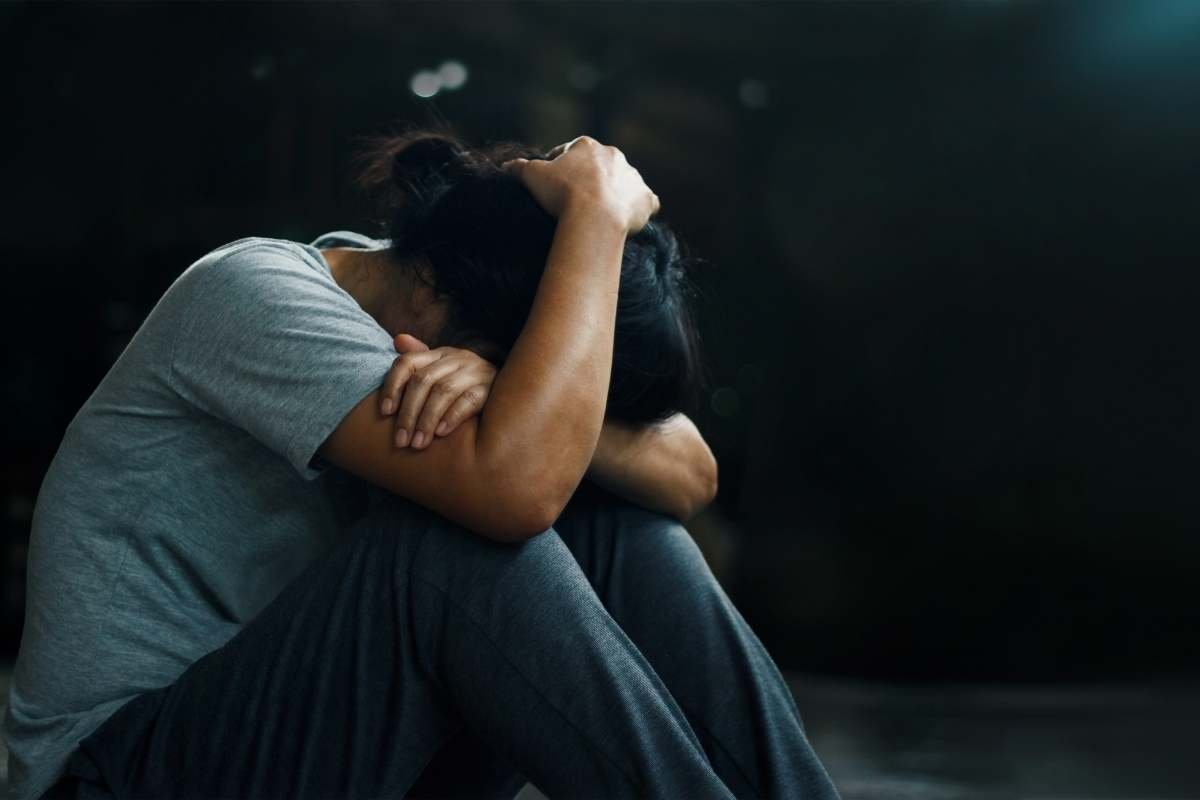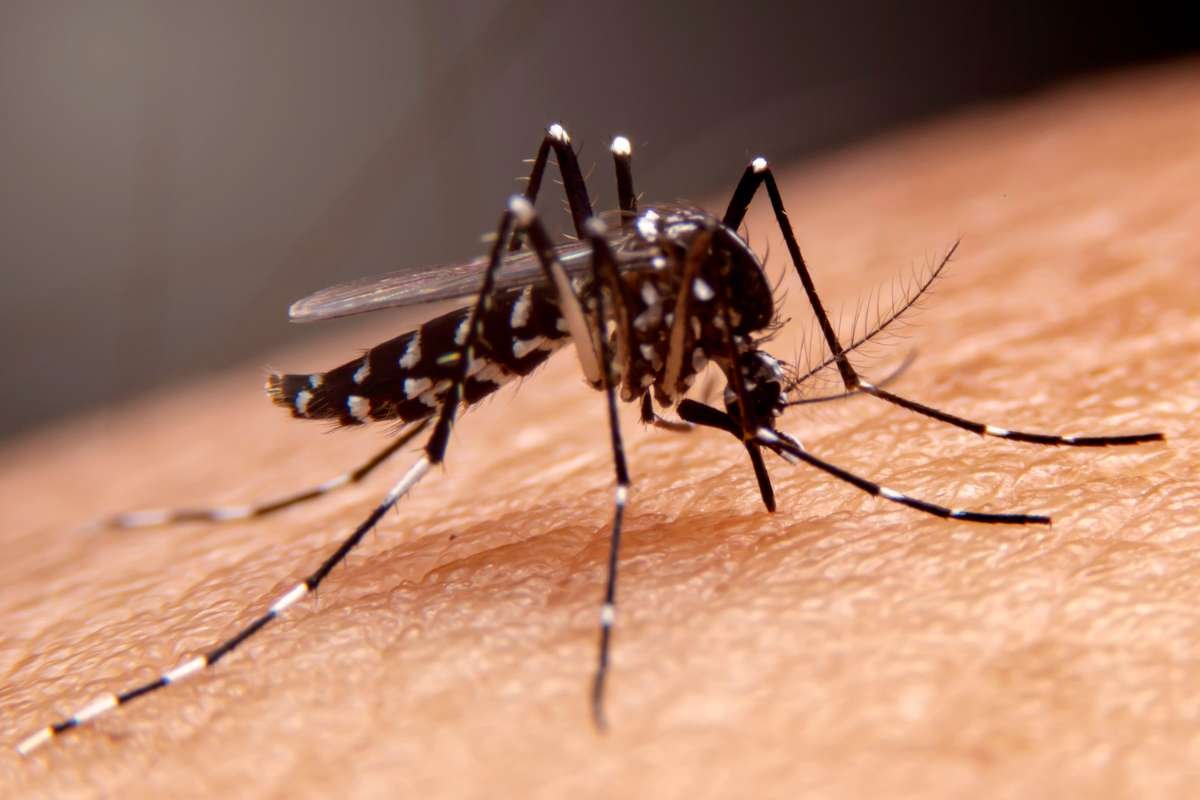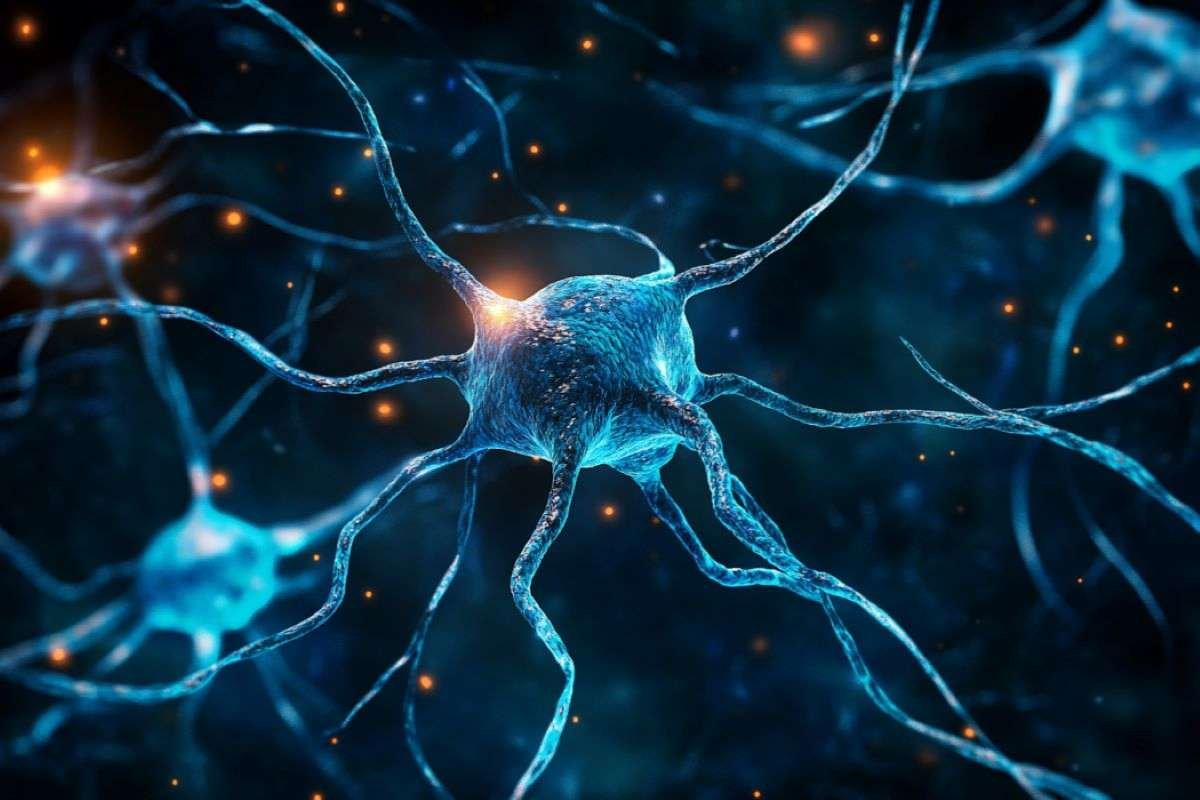Painful events don’t always fade with time. Sometimes, they live on through generations, silently shaping lives, thoughts, emotions, and behaviors. This phenomenon is known as intergenerational trauma (IT).
It’s the emotional, psychological, and even physical toll passed down from parents to children, and often even grandchildren. Understanding IT is not only necessary for healing but essential for breaking the cycle.
In this article, we will explore what IT is, why it happens, what symptoms to look for, treatment options, and real-life stories that bring this topic to light. The goal is to provide a clear and helpful guide that helps people understand, identify, and start addressing this deep-rooted form of trauma.
So What Exactly is Intergenerational Trauma and Why Does it still Hurt Today?
IT refers to the transmission of emotional wounds, fear, shame, and dysfunctional coping strategies from one generation to the next. It doesn’t happen through genes alone, but more often through behaviors, family patterns, and environments.
When a parent or grandparent doesn’t heal from trauma like war or abuse, they often pass that pain on through their stress, relationships, and parenting.
This means a child can grow up feeling unsafe or unloved, not because the parent is cruel, but because the parent never learned how to feel safe or love without fear.
What Causes Intergenerational Trauma You Might Be Missing?
Several factors contribute to IT:
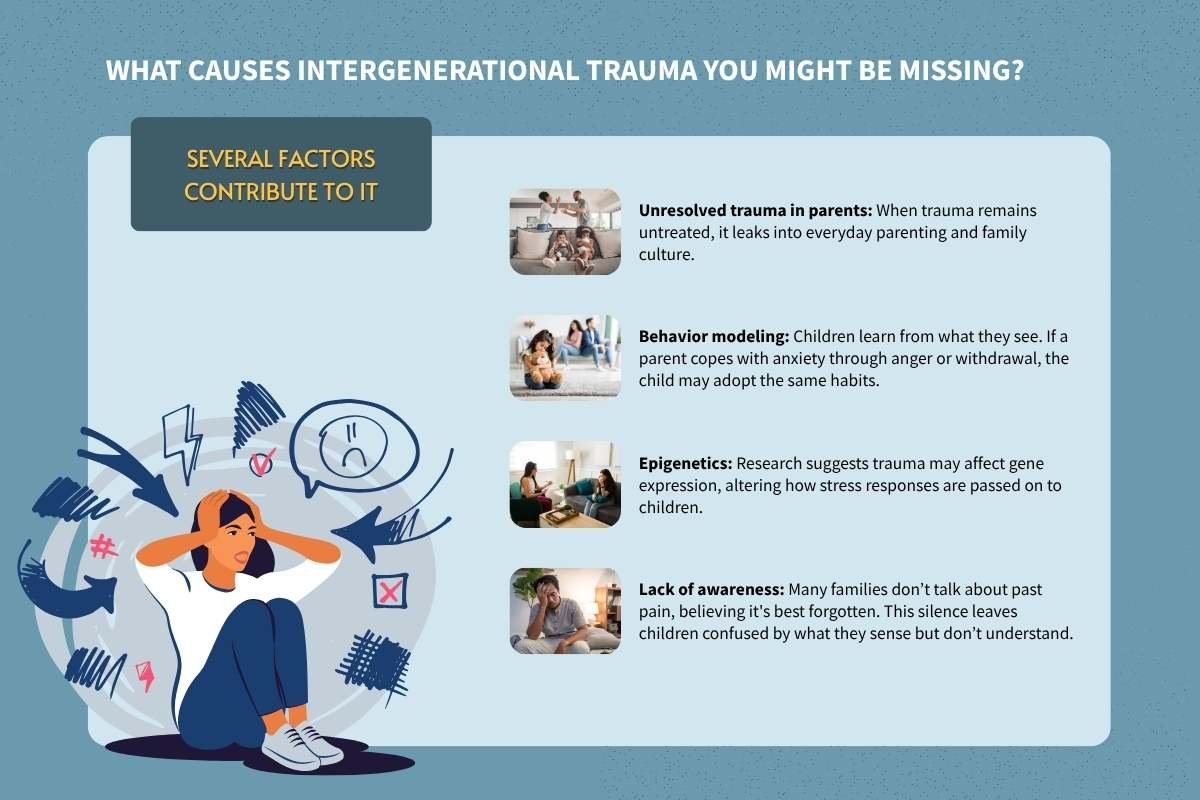
- Unresolved trauma in parents: When trauma remains untreated, it leaks into everyday parenting and family culture.
- Behavior modeling: Children learn from what they see. If a parent copes with anxiety through anger or withdrawal, the child may adopt the same habits.
- Epigenetics: Research suggests trauma may affect gene expression, altering how stress responses are passed on to children.
- Lack of awareness: Many families don’t talk about past pain, believing it’s best forgotten. This silence leaves children confused by what they sense but don’t understand.
IT isn’t always about what’s said. Often, it’s about what’s left unspoken.
Common Symptoms of Intergenerational Trauma
Recognizing IT can be tricky, as its signs often mimic regular emotional struggles. But certain patterns tend to repeat:
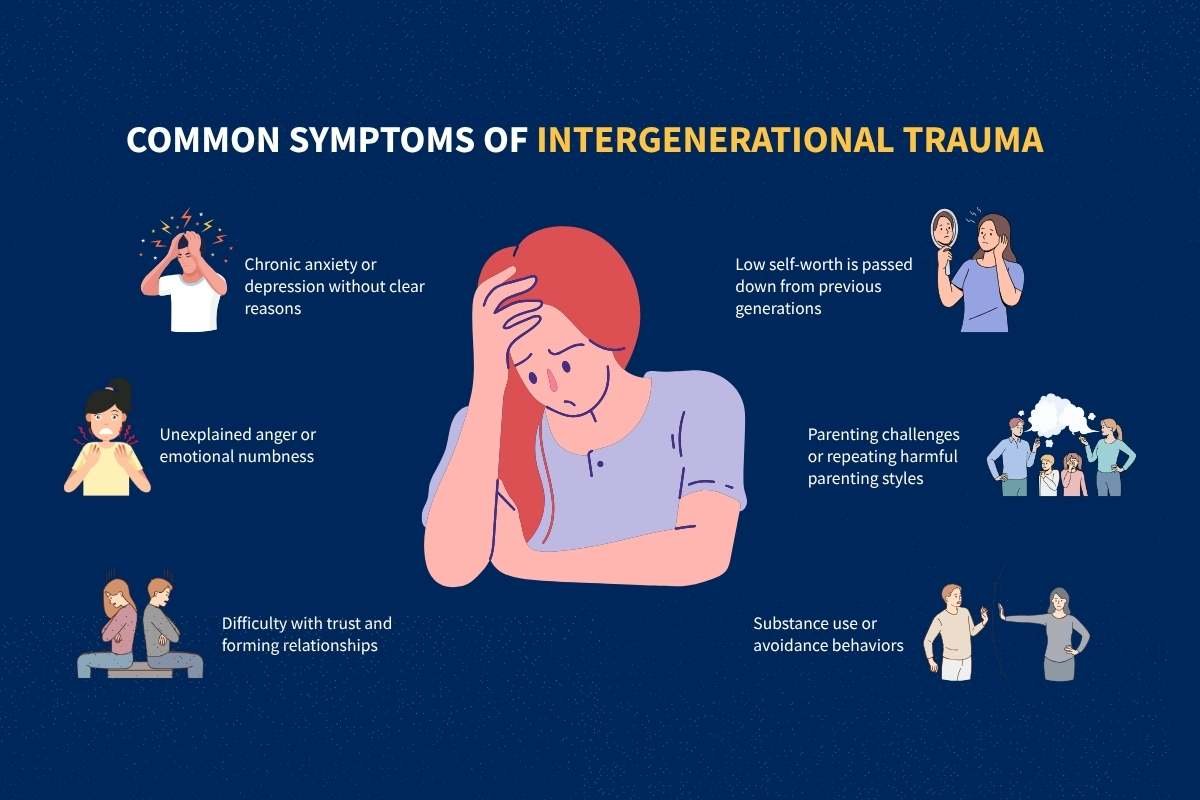
- Chronic anxiety or depression without clear reasons
- Unexplained anger or emotional numbness
- Difficulty with trust and forming relationships
- Low self-worth is passed down from previous generations.
- Parenting challenges or repeating harmful parenting styles
- Substance use or avoidance behaviors
These symptoms may appear in young children, teens, or adults. Often, people don’t realize that their emotional struggles might be rooted in past family pain rather than personal failure.
Case Study 1: Holocaust Survivor Family (United States)
Sarah grew up in New York, the daughter of Holocaust survivors. Her parents never spoke of their past but lived in a constant state of fear. Sarah recalls doors always locked, lights always on, and silence during mealtimes.
As an adult, Sarah struggled with panic attacks and a deep fear of losing loved ones. Only during therapy did she learn about intergenerational trauma and realize her anxiety mirrored the terror her parents carried.
This discovery helped Sarah start her healing journey and slowly unlearn the behaviors that were never truly hers to carry.
Case Study 2: Indigenous Communities (Australia)
Among Aboriginal Australians, intergenerational trauma is a widespread issue. The “Stolen Generations,” where children were taken from their families, led to massive psychological damage. This trauma, combined with systemic racism and poverty, has echoed through generations.
Today, high rates of substance abuse, mental health issues, and suicide in Indigenous populations can be traced back to those original policies. Activists and therapists in Australia work with communities to address these wounds through storytelling, cultural reconnection, and group healing.
Break the Cycle, Break the Silence, Break the Pattern
Though the effects are real, intergenerational trauma is not a life sentence. Healing is possible.
1. Awareness Is Step One
The first step is acknowledging that this trauma exists. Many people resist this idea, believing that what happened in the past has nothing to do with the present. But recognizing the patterns is necessary for change.
2. Therapy and Professional Help
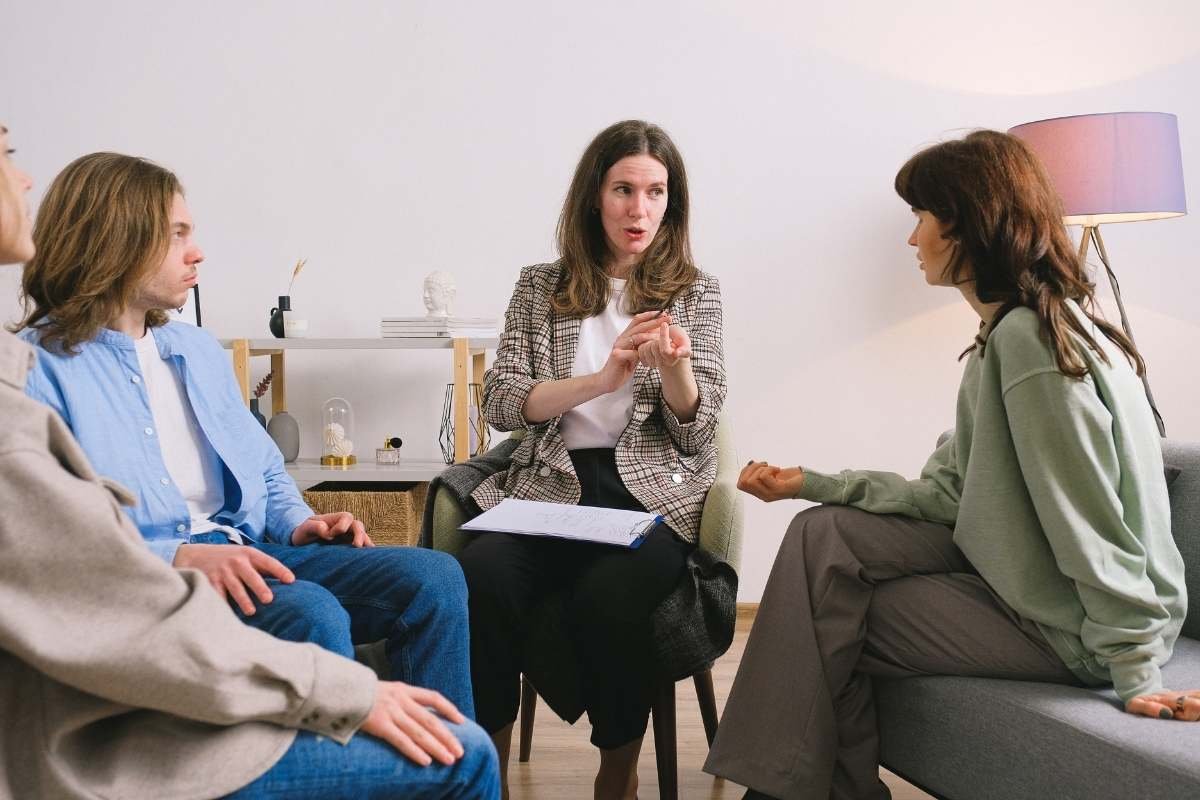
- Trauma-focused therapy, such as EMDR (Eye Movement Desensitization and Reprocessing) or Internal Family Systems, can help people process not just their trauma, but inherited emotional pain.
- Family therapy allows multiple generations to speak, listen, and understand each other.
- Working with culturally competent therapists is crucial, especially in cases where racial or historical trauma plays a role.
3. Building Emotional Safety
Creating safe, supportive environments at home, school, or community spaces helps disrupt harmful patterns. Emotional safety encourages vulnerability, which is the foundation of healing.
4. Cultural Healing and Rituals
In some communities, traditional healing methods, like storytelling, drumming, or dance, serve as powerful tools to release trauma. These practices honor the past while helping people reclaim their identity.
Case Study 3: Rwandan Genocide Aftermath (Africa)
After the 1994 genocide, survivors in Rwanda struggled with PTSD, grief, and fear. Many children born after the genocide displayed signs of intergenerational trauma, including nightmares and emotional detachment.
Nonprofit organizations introduced storytelling therapy in schools and communities. Children and adults shared stories of loss, hope, and survival. Over time, those who engaged in these activities showed marked improvements in emotional stability and interpersonal relationships.
This example shows how storytelling and community rebuilding can create real healing.
How Parenting Passes Down Pain or Breaks the Cycle of Intergenerational Trauma?
Parenting plays a critical role in the transmission or interruption of trauma.
When parents carry unhealed wounds, they may unintentionally parent from a place of fear, control, or emotional unavailability. This creates confusion and emotional distress for the child.
But when parents recognize their patterns and seek help, they create space for healthier emotional connections.
Even small steps, like apologizing to a child, listening without judgment, or learning new ways to express love, can change the family’s emotional future.
Not All Trauma Is the Same. Here’s How Intergenerational Trauma Stands Apart
It’s helpful to know how IT is different:
- Acute trauma happens from a single event, like an accident or assault.
- Chronic trauma comes from ongoing exposure, like domestic violence.
- Complex trauma involves multiple traumatic events over time.
Intergenerational trauma, however, may involve none of these direct experiences but still leave deep marks due to the emotional inheritance from parents or ancestors.
Here’s How Communities Heal Intergenerational Trauma Together
Healing IT is not an individual task. Entire communities carry wounds, especially those affected by colonization, slavery, or genocide. That’s why collective healing is powerful.
Support groups, memorial events, cultural festivals, and educational programs all play a role in acknowledging pain and offering paths to recovery.
In South Africa, for example, the Truth and Reconciliation Commission allowed people to share their stories of apartheid trauma. This helped not only individuals but an entire nation begin the process of healing together.
Want to Break the Cycle for Good? Here’s How to Heal Intergenerational Trauma
Healing looks different for everyone. Here are some proven approaches:
- Talk Therapy: Helps identify inherited patterns and develop healthier responses.
- Somatic Experiencing: Focuses on body-based trauma release.
- Mindfulness and Meditation: Build self-awareness and emotional regulation.
- Creative Therapy: Art, music, and writing can give voice to unspoken pain.
- Journaling and Family Mapping: Tools like genograms help uncover trauma patterns.
Each of these treatments is more effective when paired with professional guidance and emotional support from loved ones.
Signs You Are Healing from Intergenerational Trauma
Healing is not quick, but it’s real. Here are signs that progress is being made:
- You begin setting boundaries that protect your peace.
- Emotional reactions feel more manageable.
- You understand your parents with compassion, not blame.
- You notice healthier patterns forming in relationships.
- You feel more connected to your own identity.
Remember, healing doesn’t erase the past; it frees you from being trapped in it.
Also Read: Exploring the Effects of Childhood Trauma
Conclusion
Intergenerational trauma doesn’t define who you are. It’s a piece of your story, not the whole book. When you name the pain, understand its roots, and begin to make changes, you give yourself and future generations the gift of peace.
Real healing starts when one person says, “It stops with me.” Let that person be you.

